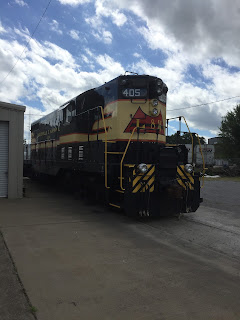
The Tennessee Central Railway was founded in 1884 by Jere Baxter. The original intent of the line was to transport coal throughout various towns. The route ran from Hopkinsville, Kentucky to Harriman, Tennessee. At the railway's peak, it covered 296 miles. The base for the Tennessee Central was located in Nashville, Tennessee. It was here, that offices, maintenance shops, locomotives, and train cars were housed. The railway system consisted of individual towns, with a depot in each. Over the years, the TC gained and lost various rail lines. The railway also underwent numerous changes in ownership. In July 1946, the railway changed ownership, and with it, the type of locomotives that were used. In an effort to keep costs down, the TC made the switch from steam powered locomotives to diesel powered ones. The TC ran passenger trains until 1955, this led to the closure of various depots, including the "Crown Jewel of the TC," the Cookeville Depot. The reason for this discontinuance in service was the automobile. People did not want to wait around for a train, when they could get in a car and have their own schedule. As the 1960s came, prices on coal began to drop. This eventually led to the closure of the railway in 1968. Most of the lines were absorbed by the Louisville and Nashville Railway. Most towns along the route chose to demolish their depots. The rail yard in Nashville eventually became a museum, that is still in operation today. Most of the locomotives and rail cars were sold, but a few were kept. Those that were kept have been put on display at the Tennessee Central Railway Museum, in Nashville. It is through the preservation efforts of many, that the legacy of the Tennessee Central Railway lives on.

Map of the entire Tennessee Central Railway.
Jere Baxter, founder of the Tennessee Central.
The Tennessee Central Rail yard in Nashville, as it appeared in the railway's heyday.
Locomotives, like 509, were used by the Tennessee Central until the ownership change in 1946. Sadly many of them have been scrapped. The red caboose behind 509, is known as "TC 9828."
After the 1946 ownership change, most of the diesel locomotives that were purchased were "alco" cabs, with a "streamline" design This particular one, is still in operation today, it pulls the annual Fall excursion trains.
The Tennessee Central also purchased locomotives like the one above. Known as "switchers," they rarely left the yard. They were used to make sure that the correct cars and cargo were connected to the correct trains.
The Tennessee Central Railway Museum, is involved in the restoration of locomotives and train cars. Above is one of their many projects.
The Tennessee Central Railway Museum is home to actor Jackie Gleason's personal train car. All of the TC's passenger cars are "streamline" design.
Stay tuned for more blog posts about tales from Tennessee and beyond, including my big announcement.




























